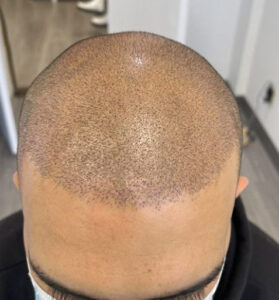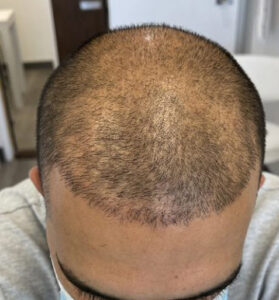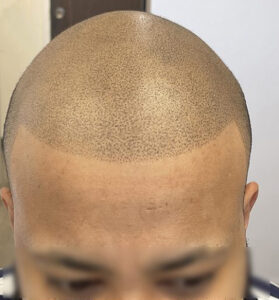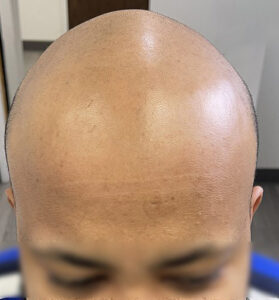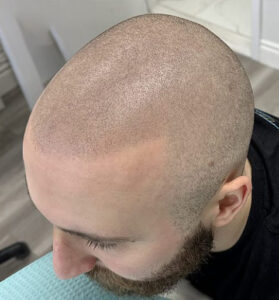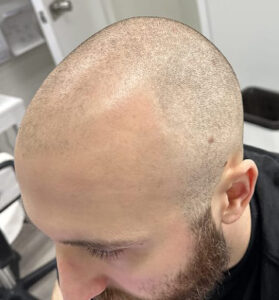SMP for FUT and FUE
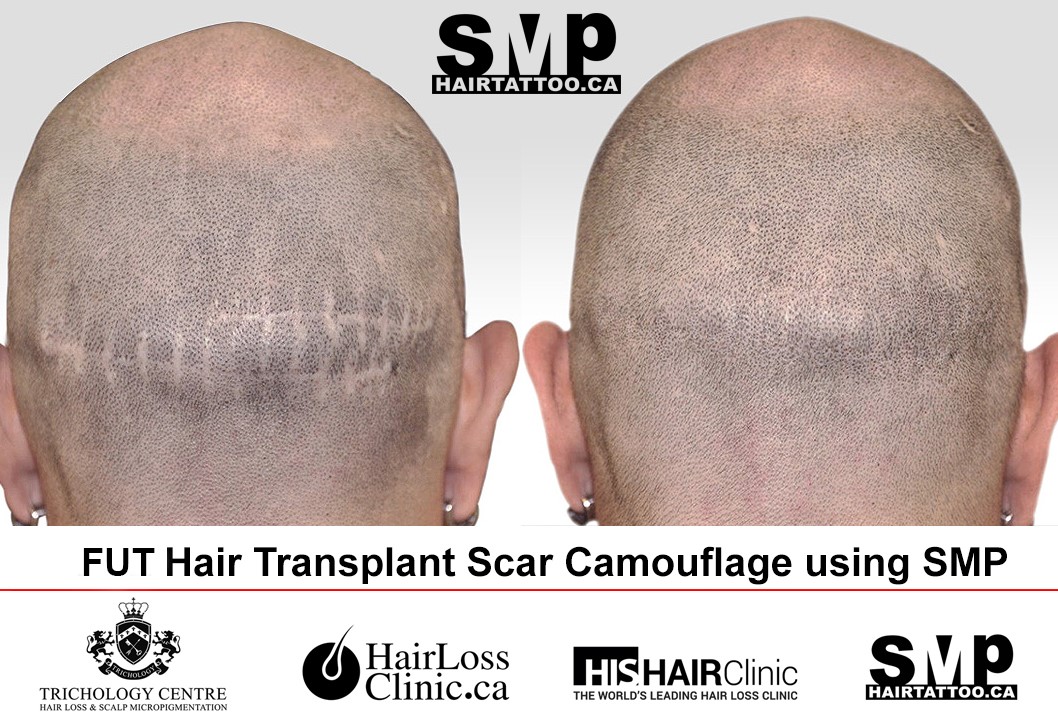
Table of Contents
- FOLLICULAR UNIT TRANSPLANTATION(FUT): This procedure may also be known as Follicular Unit Strip Surgery (FUSS). In this hair transplant technique, the surgeon cuts out a 6 to 10-inch strip of scalp skin from the back of the head. That area is then sewed and closed with stitches. The surgeon then begins to separate and divide the portion of the removed scalp into smaller units. The type of graft you get depends on how small or big the treatment area is, the type of hair you have, and the colour of your hair.
- FOLLICULAR UNIT EXTRACTION (FUE): In follicular unit extraction, the surgeon will shave and cut out from the back of the head, hair follicles in the area using thousands of tiny punch incisions. In the location of the scalp that is getting the hair transplant, the surgeon creates small holes with a needle or a scalpel.
- The surgeon and his team would transplant hair into the area. A bandage would then be used to cover and protect the area. This process usually takes about 4 to 8 hours, and the stitches get removed several days (usually ten days) after the surgery. To get the full head of hair you want, you may need 3 to 4 more sessions several months apart.
- It creates an illusion of a full head of hair if you have started thinning out or lost a lot of hair for any reason.
Table of Contents
MICROPIGMENTATION SCALP FOR HAIR TRANSPLANT SCARS
Micropigmentation scalp treatment can reduce the appearance of scars from hair transplant procedures, including FUT and FUE. Hair transplant procedures, particularly FUT, leave a linear scar where the donor’s hairs are removed.
The amount of scarring varies depending on the type and the amount of skin removed during the procedure. SMP can make the scarred area look like natural hair, effectively covering the scar. SMP can also increase the thickness of the scarred skin, making it less noticeable.
When used to reduce the size of a scar, SMP is often combined with permanent makeup to create a more natural appearance. SMP can also create a hairline tattoo to cover areas of the scalp with thinning hair or a receding hairline.
Scars on the head are typical for a variety of reasons; these scars may be gotten from an accident, or perhaps they could be obtained from a hair transplant surgery.
Micropigmentation Scalp is a procedure that covers these scars by implanting organic ink into the scalp so that the completed result appears seamless with the surrounding existing hair, giving it a harmonious look.
This is an ideal procedure for people with receding hairlines, bald spots, patches, and scars that were gotten from having a hair transplant procedure. It restores the look of fuller healthy hair by creating and replicating the appearance of tiny hair.
The practitioner uses specialized micropigmentation scalp ink and equipment to replicate the look of hair follicles.
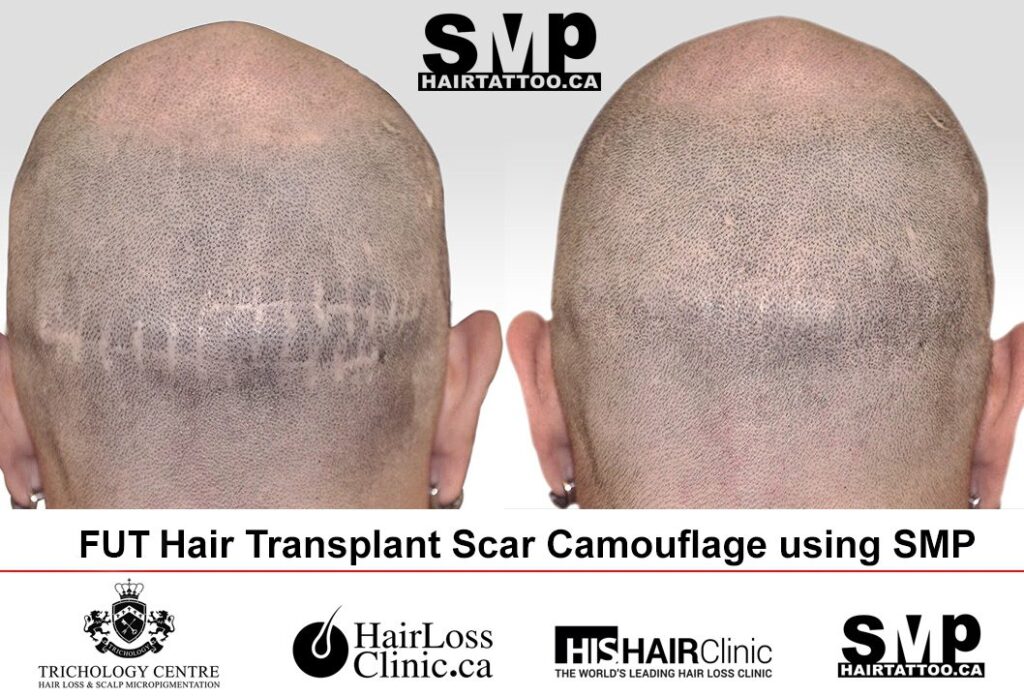
BENEFITS OF MICROPIGMENTATION SCALP
- This hair-tattoo treatment is non-invasive and requires no surgery. Downtime is only a slight redness on the scalp for a few days
- It has been proven to be 100% effective and totally worth its good reviews.
- because it replicates the look of real hair, and most times, no difference can be noted.
- After the procedure, it does not require much maintenance since you go for a touch-up every 2 to 5 years, depending on the desired results.
- It is not costly and is quite budget-friendly compared to hair transplants or ongoing hair loss treatments.
- It can be used as a good way of camouflaging or concealing obvious scars on the head.
- It creates an illusion of a full head of hair if you have started thinning out or lost a lot of hair for any reason.
WHAT IS A HAIR TRANSPLANT?
This form of treatment for hair loss is different than scalp micro pigmentation in many ways, both positively and negatively.
Typically, hair transplants are the most common form of hair restoration that people would try, but they can also be considered too invasive, too much downtime, and costly to some people.
Hair Transplants are helpful to people suffering localized hair loss that leaves the hair looking poorly spaced and visually uneven. Hair follicles can easily be taken from where there’s a surplus of hair and added to the area where hair is needed.
TYPES OF HAIR TRANSPLANT
There are 2 different main types of hair transplants, these are:
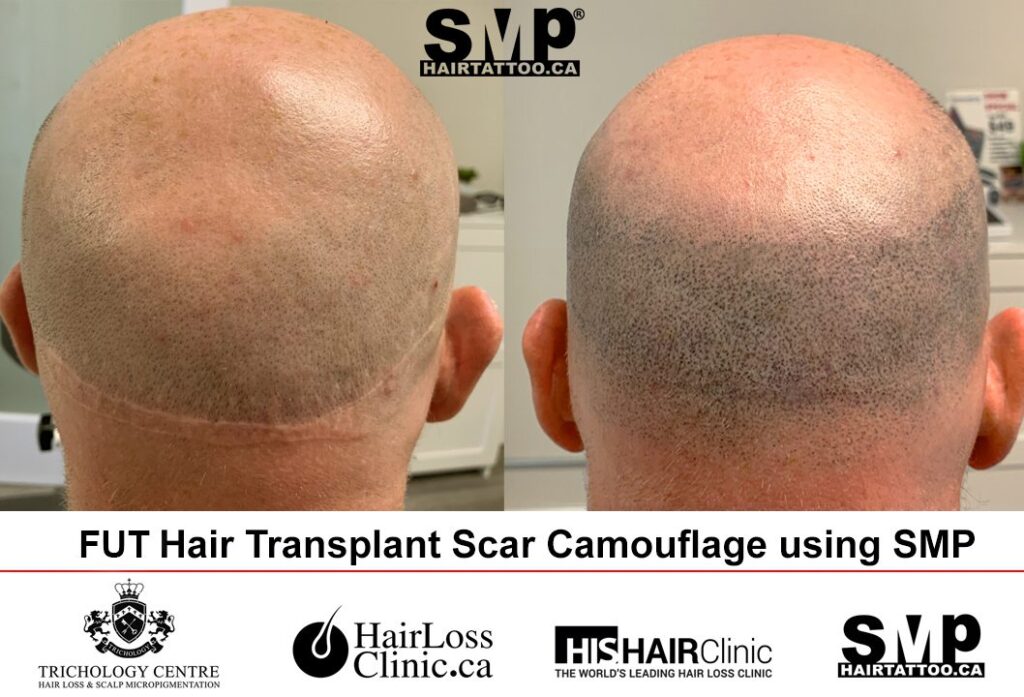
BENEFITS OF HAIR TRANSPLANT
- This procedure is a good way of eliminating baldness which would give you more confidence in your looks and self-esteem.
- It has a higher success rate than the other procedures, which is why most people choose this treatment over other
- Hair transplant surgery improves the appearance of a person.
- It requires low maintenance since it is like natural hair.
- This procedure looks more natural than other methods.
- Hair transplant treatment is cost-effective.
A hair transplant is not suitable for everyone. For patients that don’t have enough donor’s hair, a hair transplant is not recommended.
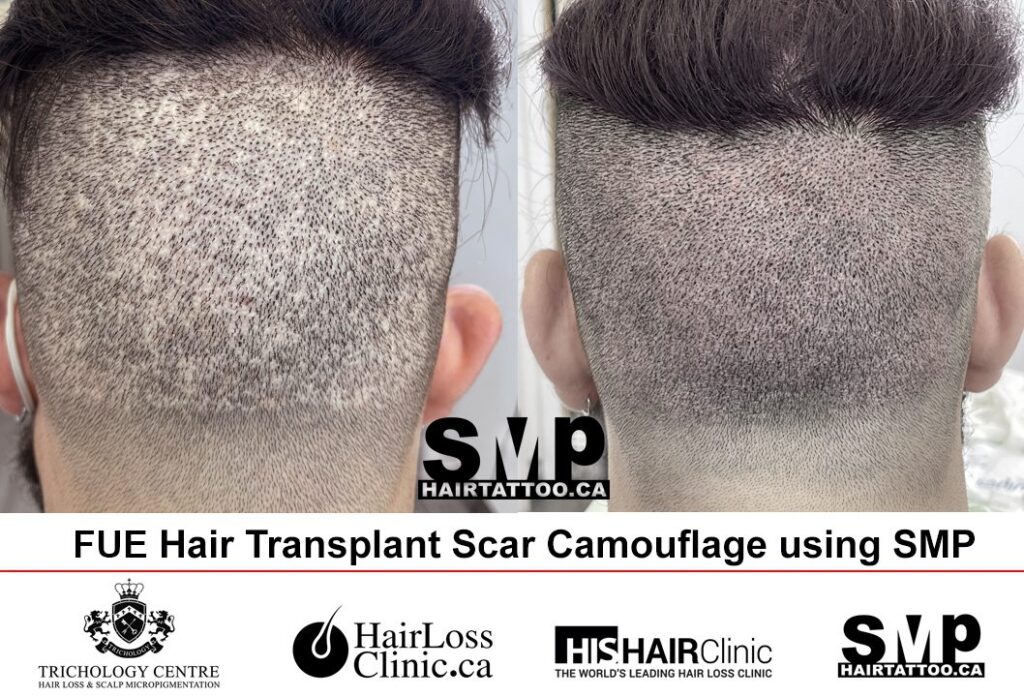
SMP FOR FUE AND FUT HAIR TRANSPLANT SCARS
Follicular Unit Extraction (FUE) Although advertised as a less invasive and scar-free treatment, it is not always the case. Though the scars may be difficult to spot, they can make people feel self-conscious if the hair is cut too short and the scar dots are noticeable.
Micropigmentation scalp easily masks this type of transplant using tattoos matching the patient’s hair colour. This gives the hair a healthy and fuller look with no scars.
SMP FOR HAIR TRANSPLANT SCARS
The scars from this procedure typically look linear and are pretty noticeable. They are large and usually only wholly hidden when the patient grows hair long enough to cover them. SMP offers an alternative to that. The scars from this procedure typically look linear and are pretty noticeable. They are large and usually only wholly hidden when the patient grows hair long enough to cover them. SMP offers an alternative to that.
Small tattoos will shade the scars to blend in with the rest of the hair. With SMP for FUT scars, striped scars are camouflaged, and the hair looks healthy.
Q&A
What is the purpose of micropigmentation scalp treatment?
Micropigmentation scalp treatment is designed to reduce the appearance of scars from hair transplant procedures and to replicate the look of natural hair, effectively covering scars and creating the illusion of a fuller head of hair.
What kinds of scars does SMP treat effectively?
SMP effectively treats scars resulting from hair transplant procedures like FUT and FUE and other scars on the scalp that may have arisen from accidents.
How does micropigmentation scalp differ from traditional hair transplant procedures?
Hair transplants shift actual hair follicles, whereas micropigmentation uses organic ink to replicate the look of these follicles on the scalp, serving as a non-surgical beauty treatment.
How often does one need maintenance after undergoing an SMP procedure?
After the initial procedure, maintenance typically involves a touch-up every 2 to 5 years, depending on the desired results.
Why might someone opt for SMP over a hair transplant?
SMP is non-invasive, requires minimal downtime, is more budget-friendly than many hair transplant options, and can effectively camouflage scars and create the appearance of a fuller head of hair.
Which two primary hair transplant methods are highlighted?
Follicular Unit Extraction (FUE) and the strip method (FUT) are the two primary forms of hair transplants.
How does SMP aid in camouflaging FUE scars?
While FUE is often marketed as less scarring, there may still be noticeable dot-like scars. SMP masks these by using tattoos that match the patient’s hair colour, giving a fuller and seamless appearance.
What is the typical appearance of scars from FUT hair transplant procedures?
Scars from FUT procedures typically appear linear and are more noticeable, often requiring the patient to grow their hair longer to hide them.
How does micropigmentation scalp work in disguising hair transplant scars?
The procedure involves applying pigments to the scalp with a microscopic needle to simulate the look of hair follicles. These pigments are carefully chosen to match the patient’s natural hair colour and skin tone for a realistic result.
What factors are essential for achieving the best results with a micropigmentation scalp?
Selecting a qualified and experienced micropigmentation practitioner who understands the individual’s needs is crucial. Open communication between the patient and the practitioner is vital in achieving the desired outcome.
TAKEAWAY
Micropigmentation scalp is a cosmetic procedure used to camouflage hair transplant scars. Hair transplant surgery can leave visible scars on the scalp, which can be a source of self-consciousness for some individuals.
Micropigmentation scalp can be used to create the appearance of a full head of hair, disguising the scars and restoring the patient’s confidence.
Micropigmentation scalp involves the application of pigments to the scalp using a microscopic needle to simulate hair follicles. This technique creates the appearance of hair and can be used to fill areas of the scalp where hair growth is sparse or non-existent. The pigments in the procedure match the patient’s hair colour and skin tone to achieve a natural-looking result.
One of the main advantages of micropigmentation scalp for hair transplant scars is that it is a non-surgical and non-invasive procedure, making it a low-risk option for those who may not want to undergo additional surgery. The procedure also requires minimal maintenance, with occasional touch-ups needed to maintain the appearance of the treatment.
To achieve the best results, selecting a qualified and experienced micropigmentation scalp practitioner who can tailor the treatment to the individual’s specific needs is essential. In addition, communication between the patient and the practitioner is crucial to achieving the desired outcome.
Overall, a micropigmentation scalp can be an effective solution for those who wish to conceal hair transplant scars and achieve a natural-looking appearance. In addition, by restoring the patient’s confidence and self-esteem, a micropigmentation scalp can positively impact their quality of life
Working Hours
- Monday 10:00AM – 8:00PM
- Tuesday 10:00AM – 8:00PM
- Wednesday 10:00AM – 8:00PM
- Thursday 10:00AM – 8:00PM
- Friday 10:00AM – 8:00PM
- Saturday 10:00AM – 8:00PM
- Sunday - Closed
Quick Contacts
- 7549 Kalar Rd, Niagara Falls, L2H 2Y6
- Toronto: 600 Sherbourne St #605, Toronto, M4X 1W4
- Richmond Hill: 8763 Bayview Ave #5, Richmond Hill, L4B 3V1
- Mississauga: 1358 Hurontario St #B2, Mississauga, L5G 3H4
- Winnipeg: 712 St Mary's Rd, Winnipeg, MB R2M 3N1
- INFO@HAIRTATTOO.CA
- (647) 492-5022 Toronto GTA
- (204) 809-5885 Winnipeg
- 2023 HAIRTATTOO.CA | Scalp Micropigmentation & Trichology Centre



